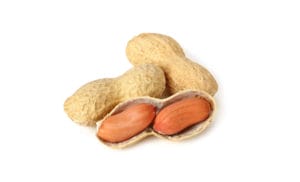
Phase 3 results from the European clinical trial of the Palforzia peanut OIT treatment show that desensitization to the allergenic legume can begin in a short period of time.
After only nine months of oral immunotherapy with Palforzia, 58 percent of participants in the treatment group could tolerate 1,000 milligrams of peanut protein in a single dose during their study exit food challenge. That level was a key study goal, and the equivalent to eating about three to four peanut kernels.
The results of the European study, known as ARTEMIS, were largely consistent with the larger Phase 3 study in North America, called PALISADE. In both placebo-controlled trials, the median tolerated dose of participants upon entering the study was 10 mg – while the median tolerated dose on leaving the study was 1,000 mg.
Each study involved six months of updosing on Palforzia to reach a maintenance dose of 300 mg. However, the maintenance period in ARTEMIS was only three months, compared to six months in the PALISADE study.
“What these two studies tell you is that the desensitization kinetics are relatively fast. We’re seeing the same results at nine months that we’re seeing at 12 months,” said Dr. Daniel Adelman, chief medical officer of Aimmune Therapeutics, the company developing the peanut allergy therapy.
But while desensitization may start quickly, Adelman says previous Palforzia research reveals that changes continue to occur within a patient’s immune system over time on the peanut allergy treatment.
“There are really two processes that go on with desensitization immunotherapy,” Adelman told Allergic Living. “There’s the shorter term acute desensitization, and there’s the longer term process which is modulation of the immune response.” In a PALISADE extension study, researchers saw steady maturing in the immune systems of patients over two years of Palforzia treatment.
European Approval Sought
The ARTEMIS clinical trial was conducted at 18 hospital sites across Europe. It involved 175 children and teens between the ages of 4 and 17, with 132 receiving treatment and 43 receiving a placebo. (Neither group knew whether they were receiving active treatment.)
Aimmune is seeking approval for Palforzia with European regulators as a therapy for peanut allergy in children and teens, and the ARTEMIS study is a key part of the licensing application. Adelman says a decision is expected before the end of 2020.
The FDA approved Palforzia as a treatment in the United States for peanut-allergic patients aged 4 to 17 years old at the start of 2020. To prescribe the approved treatment, American allergists need to be registered under a REMS (Risk Evaluation and Mitigation Strategy) safety program.
Treatment and Symptoms

The safety results in the ARTEMIS trial are similar to those in the North American trial, with symptoms experienced by most participants. “You are giving peanut to people who are allergic to peanut,” notes Adelman. “As with any immunotherapy, you will elicit some allergic reactions.” In the treatment group, most symptoms were mild or moderate. While one severe reaction was reported in the European trial, it was not severe anaphylaxis.
Adelman says most symptoms occur within two hours of dosing, and most often during updosing. He says Palforzia has “a manageable safety profile, which gets better over time. You’re more likely to have allergic reactions early in the desensitization process, which makes perfect sense – because you are in the early stages of desensitizing.” All patients and families are trained on managing reactions.
Palforzia has now been tested through three large Phase 3 clinical trials. “The results are remarkably consistent and we’ve treated over 1,200 patients,” notes Adelman. “It should give people comfort that this is a well-studied product.”
Key Artemis Phase 3 Study Results
- 58% of participants on the Palforzia treatment tolerated a single 1,000-mg dose of peanut protein dose in an exit food challenge. (This compared to 2% in the trial’s placebo group.) Since the challenge involved taking gradually increasing amounts over a few hours, this group in fact successfully consumed a cumulative 2,043 mg of peanut protein – about seven peanut kernels.
- 68% of participants on Palforzia treatment tolerated 600 mg at the exit challenge, compared to 9% of the placebo group.
- 74% in the treatment group tolerated 300 mg in the exit challenge, compared to 16% in the placebo group.
- Adverse events most frequently affected the gastrointestinal tract, respiratory system, and skin, which is consistent with other peanut OIT trials. No cases of eosinophilic esophagitis were reported.
Related Reading
Artemis Phase 3 Study Results in The Lancet
Palforzia OIT Study Sees Maturing of Immune System with Time
Dr. Michael Manning on the Basics of Oral Immunotherapy
FDA Approves Aimmune’s Palforzia OIT





